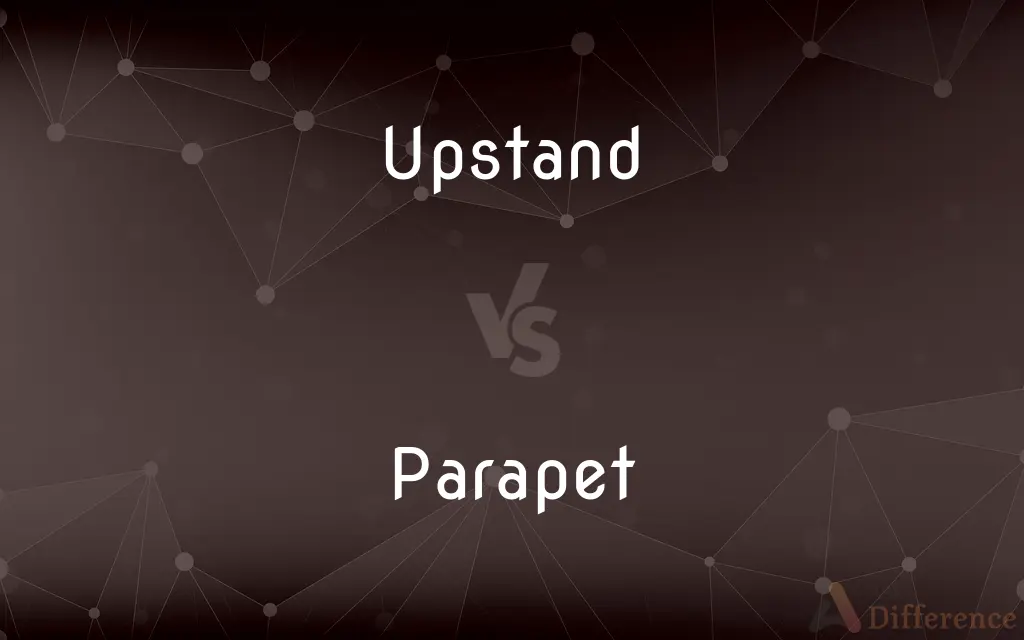Upstand vs. Parapet — What's the Difference?
Edited by Tayyaba Rehman — By Maham Liaqat — Updated on March 2, 2024
An upstand is a raised section of a floor or roof to prevent water ingress or to support installations, while a parapet is a low protective wall along the edge of a roof, balcony, or bridge, primarily for safety and architectural aesthetics.

Difference Between Upstand and Parapet
Table of Contents
ADVERTISEMENT
Key Differences
An upstand is designed to create a physical barrier for water or to provide a recess for insulation and waterproofing around the edges of flat roofs or floors. It serves a functional purpose in building construction, ensuring that elements like water do not penetrate the building envelope. On the other hand, a parapet extends above the line of the roof or floor, offering not only a safety barrier to prevent falls but also serving as an architectural feature that can enhance the building's appearance.
Upstands are critical in the detailing of junctions where the roof meets other building elements, such as walls or other roofs. They help to direct water away from these vulnerable points, minimizing the risk of leakage and water damage. Whereas parapets, beyond their practical safety function, can also hide roofing materials or equipment from view, contributing to a cleaner and more unified architectural expression.
The height of an upstand is determined by building regulations and the specific requirements of the construction detail, often related to the expected level of water or the insulation thickness. Parapets, while also subject to building codes, may vary in height more significantly based on architectural design, historical style, or specific safety considerations.
In terms of construction materials, upstands can be made from concrete, metal, or waterproofed masonry, chosen for durability and compatibility with the roof system. Parapets might be constructed from similar materials but can also include decorative elements such as coping stones, metal railings, or even glass, reflecting their dual role in function and design.
While both upstands and parapets are integral to the structure and functionality of buildings, their primary distinction lies in their purpose and location. Upstands are fundamentally about preventing water ingress and supporting the roof structure, while parapets focus on safety and aesthetics, often becoming a defining feature of the building's silhouette.
ADVERTISEMENT
Comparison Chart
Purpose
Prevents water ingress, supports installations
Safety barrier, architectural aesthetics
Location
Edges of roofs, floors
Edge of roofs, balconies, bridges
Function
Water diversion, insulation support
Fall prevention, concealment of equipment
Height Determination
Building regulations, functional requirements
Building codes, design considerations
Materials
Concrete, metal, waterproofed masonry
Similar, plus decorative elements like coping stones
Compare with Definitions
Upstand
A raised edge on a flat roof to prevent water ingress.
The upstand was added to ensure the roof remained watertight.
Parapet
Varies in height based on design and safety needs.
The bridge's parapet was heightened for extra security.
Upstand
Regulated by building standards.
The upstand height meets the minimum requirement for water drainage.
Parapet
Can be decorative, with various design elements.
Coping stones topped the parapet for a finished look.
Upstand
Made from durable materials compatible with roofing.
Concrete upstands were chosen for their longevity.
Parapet
A low wall along the edge of a roof for safety.
The parapet provided a barrier against falls.
Upstand
Supports insulation and waterproofing layers.
An upstand was constructed to house additional insulation.
Parapet
Enhances architectural aesthetics.
The building's silhouette was defined by its ornate parapets.
Upstand
Essential for flat roof construction.
Proper upstand detailing is crucial for preventing leaks.
Parapet
Conceals roof equipment from view.
Air conditioning units were hidden behind the parapet.
Upstand
A section of a roof covering or flashing which turns up against a vertical surface.
Parapet
A parapet is a barrier that is an extension of the wall at the edge of a roof, terrace, balcony, walkway or other structure. The word comes ultimately from the Italian parapetto (parare 'to cover/defend' and petto 'chest/breast').
Upstand
(construction) (of a beam) Having its top surface above the slab with which it integrates; "an upstand beam".
Parapet
A low protective wall or railing along the edge of a raised structure such as a roof or balcony.
Upstand
To stand up; to be erected; to rise.
At once upstood the monarch, and upstoodThe wise Ulysses.
Parapet
An earthen or stone embankment protecting soldiers from enemy fire.
Parapet
A low protective wall.
Parapet
A low wall, especially one serving to protect the edge of a platform, roof, bridge, or the like.
Parapet
A low wall along the edge of a roof or balcony
Common Curiosities
Why are upstands important in building design?
Upstands are crucial for ensuring water does not penetrate the building envelope, protecting against leaks and water damage.
What is a parapet?
A parapet is a low protective wall at the edge of a roof, balcony, or bridge, serving safety purposes and contributing to a building's aesthetic.
Do all buildings with flat roofs have upstands?
Most buildings with flat roofs will have upstands as part of modern building standards for waterproofing.
What architectural roles do parapets play?
Parapets contribute to the visual appeal of buildings, can conceal roof equipment, and are integral to the overall architectural style.
Can upstands and parapets be made from the same materials?
Yes, both can be constructed from materials like concrete, metal, or waterproofed masonry, though parapets may also include decorative elements.
What types of buildings commonly have parapets?
Buildings with flat roofs, historical buildings, and structures requiring safety barriers at heights often feature parapets.
How do upstands and parapets contribute to roof drainage?
Upstands help direct water to designated drainage points, while parapets can also support drainage by containing and directing water away.
How do parapets enhance building safety?
Parapets prevent falls from heights by providing a barrier along edges of roofs, balconies, and bridges.
Can upstands be added to existing buildings?
Yes, upstands can be added during roof refurbishment or repair to improve waterproofing and insulation.
What is an upstand in construction?
An upstand is a raised section along the edge of a flat roof or floor designed to prevent water ingress and support roofing installations.
How is the height of an upstand determined?
The height is based on building regulations and the specific requirements for waterproofing and insulation.
Are upstands visible from the ground?
Typically, upstands are not visible from the ground as they are designed to be functional rather than decorative.
What maintenance is required for upstands and parapets?
Regular inspections are necessary to ensure they remain watertight and structurally sound, with repairs made as needed to materials and waterproofing layers.
Are there historical styles of parapets?
Yes, various architectural styles feature unique parapet designs, from medieval battlements to Victorian ornamental copings.
How do building codes affect parapet design?
Building codes dictate the minimum height and structural requirements of parapets to ensure safety and compliance.
Share Your Discovery

Previous Comparison
Darkness vs. Shadow
Next Comparison
Document vs. NoteAuthor Spotlight
Written by
Maham LiaqatEdited by
Tayyaba RehmanTayyaba Rehman is a distinguished writer, currently serving as a primary contributor to askdifference.com. As a researcher in semantics and etymology, Tayyaba's passion for the complexity of languages and their distinctions has found a perfect home on the platform. Tayyaba delves into the intricacies of language, distinguishing between commonly confused words and phrases, thereby providing clarity for readers worldwide.














































